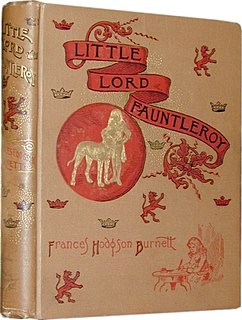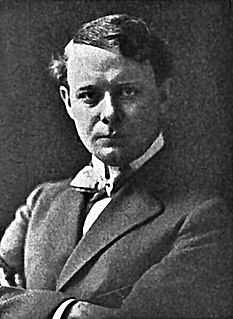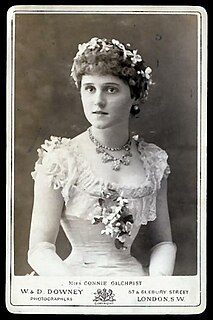
Little Lord Fauntleroy is a novel by Frances Hodgson Burnett. It was published as a serial in St. Nicholas Magazine from November 1885 to October 1886, then as a book by Scribner's in 1886. The illustrations by Reginald B. Birch set fashion trends and the novel set a precedent in copyright law when Burnett won a lawsuit in 1888 against E. V. Seebohm over the rights to theatrical adaptations of the work.

Thomas Osborne, 1st Duke of Leeds,, was a prominent English politician. Under King Charles II, he was the leading figure in the government for around five years in the mid 1670s. He fell out of favour due to corruption and other scandals, and was impeached and eventually imprisoned in the Tower of London for five years until the accession of James II of England in 1685. In 1688 he was one of the Immortal Seven group that invited William III, Prince of Orange to depose James II as monarch during the Glorious Revolution. He was again the leading figure in government, known at the time as the Marquess of Carmarthen, for a few years in the early 1690s.

Viola Dana was an American film actress who was successful during the era of silent films. She appeared in over 100 films, but was unable to make the transition to sound films.

Gilbert Talbot, 7th Earl of Shrewsbury, 7th Earl of Waterford, 13th Baron Talbot, KG, styled Lord Talbot from 1582 to 1590, was a peer in the peerage of England. He also held the subsidiary titles of 16th Baron Strange of Blackmere and 12th Baron Furnivall.

Shirley Mason was an American actress of the silent era.

Julia Frankau was a successful novelist who wrote under the name Frank Danby. Her first novel was published in 1887: Dr. Phillips: A Maida Vale Idyll. Its portrayal of London Jews and Jewish life, and its depiction of murder by a doctor were controversial. This was followed by more Frank Danby novels and by books on other subjects, including engraving, which were sometimes written under her own name. Frankau continued to write until the time of her death.
The Heart of Sister Ann is a 1915 British silent drama film directed by Harold M. Shaw and starring Edna Flugrath, Hayford Hobbs and Guy Newall. Its plot involves an orphaned dancer who repays the sister brought her up her by marrying the man she loves - after becoming pregnant by a Russian novelist.
Hayford Hobbs was a leading British film actor of the silent era and later became a film director. He was born in London, England, in 1891. He made his first screen appearance in the 1915 film The Third Generation and appeared in his last film High Treason in 1929. The following year he directed his first film, a documentary about London.

Little Lord Fauntleroy is a 1980 British family film directed by Jack Gold and starring Alec Guinness, Rick Schroder, Eric Porter, Connie Booth, and Colin Blakely. It is based on the 1886 children's novel of the same name by Frances Hodgson Burnett.
Hindle Wakes is a 1918 British silent film drama, directed by Maurice Elvey and starring Colette O'Niel and Hayford Hobbs. It is the first of four screen versions of the celebrated and controversial 1912 play by Stanley Houghton. It which was a sensation in its time for its daring assertions that a woman could enjoy a sexual fling just as much as a man, without feeling any guilt or obligation to explain herself, and that she was perfectly capable of making her own life decisions without interference from family or the need to bow to social pressures.
The Lady Clare is a 1919 British silent drama film directed by Wilfred Noy and starring Mary Odette, Jack Hobbs and Charles Quatermaine. It is based on the narrative poem Lady Clare by Lord Tennyson.

Harold Marvin Shaw was an American stage performer, film actor, screenwriter, and notable director of the silent era. A native of Tennessee, he worked professionally in theatrical plays and vaudeville for 16 years before he began acting in motion pictures for Edison Studios in New York City in 1910 and then started regularly directing shorts there two years later. Shaw next served briefly as a director for Independent Moving Pictures (IMP) in New York before moving to England in May 1913 to be "chief producer" for the newly established London Film Company. During World War I, he relocated to South Africa, where in 1916 he directed the film De Voortrekkers in cooperation with African Film Productions, Limited. Shaw also established his own production company while in South Africa, completing there two more releases, The Rose of Rhodesia in 1918 and the comedy Thoroughbreds All in 1919. After directing films once again in England under contract with Stoll Pictures, he finally returned to the United States in 1922 and later directed several screen projects for Metro Pictures in California before his death in Los Angeles in 1926. During his 15-year film career, Shaw worked on more than 125 films either as a director, actor, or screenwriter.
The Derby Winner is a 1915 British silent sports drama film directed by Harold M. Shaw and starring Edna Flugrath, Gerald Ames and Mary Dibley. It is an adaptation of an 1895 play The Derby Winner by Henry Hamilton, Augustus Harris and Cecil Raleigh.

Richard Neville, 2nd Baron Latimer KB of Snape, North Yorkshire, was an English soldier and peer. He fought at the battles of Stoke and Flodden.

Connie Gilchrist was a British child artist's model, actress, dancer and singer who, at a very early age, attracted the attention of the painters Frederic Leighton, Frank Holl, William Powell Frith and James McNeill Whistler, the writer and photographer Lewis Carroll and aristocrats, Lord Lonsdale and the Duke of Beaufort. She became a popular attraction on stage at the age of 12 in a skipping rope dance routine at London's Gaiety Theatre, where she was then engaged in Victorian burlesque and vaudeville throughout her formative years. Gilchrist, who became known as the "original Gaiety Girl", had abandoned the stage by the time of her marriage in 1892 to Edmond Walter FitzMaurice, 7th Earl of Orkney.
The Breed of the Treshams is a 1920 British silent adventure film directed by Kenelm Foss and starring Mary Odette, Hayford Hobbs and A. B. Imeson. During the English Civil War, the Royalists uncover a Roundhead spy.
The Man and the Moment is a 1918 British silent drama film directed by Arrigo Bocchi and starring Manora Thew, Hayford Hobbs and Charles Vane. It is an adaptation of the 1914 novel of the same name by Elinor Glyn.

Little Lord Fauntleroy is a 1914 British silent drama film directed by Floyd Martin Thornton and starring H. Agar Lyons, Gerald Royston in the title role, and Jane Wells. It was based on the 1886 novel Little Lord Fauntleroy by Frances Hodgson Burnett. The film was produced by the Natural Colour Kinematograph Company. It was distributed in the UK by Kineto Ltd. and released in the US by Shubert Feature Film in April of that year. It was one of the first feature-length films to be made in colour, using the Kinemacolor two-colour additive colour process.

The Heart of a Child is a lost 1920 silent film drama directed by Ray Smallwood with Alla Nazimova as star. It was scripted by Charles Bryant, Nazimova's husband and co-star. Metro Pictures distributed.

The Lady Slavey was an 1894 operetta in two acts with a score by John Crook, to a libretto by George Dance which opened at the Royal Avenue Theatre in London on 20 October 1894 and which featured May Yohé and Jennie McNulty. After a major rewrite to make it more suitable for American audiences it opened at the Casino Theatre on Broadway on 3 February 1896 where it ran for 128 performances with additional lyrics by Hugh Morton and music by Gustave Adolph Kerker.













